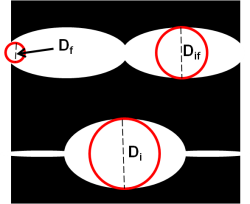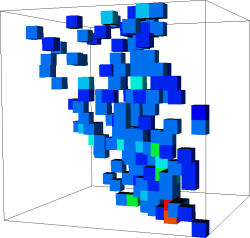A general overview
Zeo++ is a open source software for performing high-throughput geometry-based analysis of porous materials and their voids. The main code provides capabilities to calculate the following:

- Pore diameters – The typical parameters describing pore sizes are the diameters describing: (1) the largest included sphere (Di), (2) the largest free sphere (Df), and (3) the largest included sphere along the free sphere path (Dif). See the illustration on the right.
- Surface area and volume – The code can calculate probe-accessible surface area and probe-accessible volume using Monte Carlo sampling approach.
- "Per channel" analysis – The probe-accessible part of the void space can be analyzed to identify independent channel systems, their dimensionality as well as the corresponding Di, Df and Dif parameters.
- Pore Size Distribution (PSD) – PSD gives information on how much of the void space corresponds to certain pore sizes.
- Hologram representations Hologram, a histogram representing the probe-accessible void space, can be calculated and then used to perform structure-(dis)similarity analysis for a large set of material structures.

- Stochastic ray approaches – Zeo++ can generate histogram representations of the void space by shooting random rays inside the unit cell, and measuring their lenghts. The resulting histogram is a fingerprint of the void space, and it can be used to compare structures.
- Distance grid calculations – The code can calculate the grid representation of the material. The grid points are assigned the corresponding distance to their nearest atoms. The grids are saved in either Gaussian Cube or BOV file formats for an easy visualization.
- File format conversion and visualization aids – The code can perform basic operaction on files with structures and generate data for visualization: generation of supercells, ploting unit cells in VisIT and VMD etc.

The structure of the code makes it particularly well-suited to many problems in physics and materials science, where Voronoi cells can be a useful method of analyzing particle packings.
Development
Zeo++ is written and maintained by researchers of the Computational Research Division of the Lawrence Berkeley National laboratory: Maciej Haranczyk, Chris H. Rycroft, Thomas F. Willems (now at MIT) and Richard L. Martin. Some functionality was developed by interns: Marielle Pinheiro and Christopher Oustrouchov. Many functions of Zeo++ were developed after suggestions from our collaborators: Berend Smit and his group (misc), Andrew J. Jones and Enrique Iglesia (stochastic rays), Daniel Holden and Kim Jelfs (grid-based analysis and improved outputs), and Michael Deem ("per channel analysis").